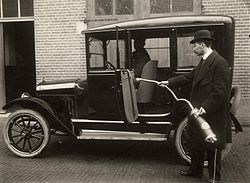
Auto detailing is an activity that keeps the vehicle in its best possible condition, primarily cosmetic, as opposed to mechanical. Detailing is achieved by removing visible and invisible contaminants from the vehicle's interior and polishing the exterior to its original blemish-free finish. The fundamental detail options include an exterior wash and wax, interior vacuuming, window cleaning, and surface polishing.
Background
Professional detailing services and the sale of products to both professionals and enthusiasts represent a significant commercial presence in places where automobiles are a major mode of transport.
The professional and home detailing industry in the United States had over $17.3 billion in revenue as of October 2023.[1]
In the United States, the market value in 2021 for car care products was estimated to be $3.12 billion.[2] Consumers are expected to spend on vehicle maintenance and appearance at a compound annual growth rate of 3.5% from 2022 through 2030.[2]
Components of detailing
Detailing is more than a cleaning process to make a vehicle look good; but a systematic approach to help extend its life with methods and products that reduce damaging environmental elements such as dirt, sun, harsh winters, etc.[3] Appropriate maintenance or restoration of vehicles to keep them looking outside and inside as if they came from an auto dealer's showroom increase their resale value.[4] Auto detailing requires knowledge of proper techniques and use of tools and products.[3]
Detailing is generally divided into exterior and interior (or cabin). Some services and most products focus on these two areas.
Exterior detailing
Cleaning and either restoring or exceeding the original condition of the surface of the car's finish (usually a paint with a glossy finish), chrome trim, windows, wheels, tires, and other visible components on a vehicle's exterior. A wide array of detailing products and techniques are used based on the vehicle's surface type and condition or the detailers' or customers' preference. Products include, but are not limited to, detergents, surfactants, acid-free degreasers (to break down dirt and soil), detail clay (to remove invisible micro-embedded surface contaminates), waxes, and silicone-and non-silicone-based dressings for plastic trim and tires. Buffing compounds and polishes to resurface and improve the reflectivity of the paint finish, as well as a variety of applicators, brushes, and drying towels.[5] Additional external detail work may include removing deeper scratches or imperfections in the paintwork. A liquid polymer may also add a protective layer to modern clear-coat automobile paints, making them more resistant to scratches and environmental damage. Modern vehicles often use polycarbonate plastic instead of glass for headlights. Exposure to sunlight oxidizes the lenses, and detailing may include restoration to remove cloudiness and revive clarity for the headlights. External detailing may also involve degreasing and cleaning the engine bay, making used internal combustion vehicles look newer and better maintained.
Interior detailing
Thoroughly cleaning all surfaces and trim of the vehicle's interior cabin and trunk or cargo areas. Over the last fifty years, car interiors have included diverse materials, such as synthetic fiber carpeting and upholstery, vinyl, leather, natural fibers, carbon fiber composites, wood, rubber, plastics, etc. The variety of components in vehicle interiors necessitates various cleaning techniques and products. Vacuuming is standard, and upholstery stains may be removed using steam cleaning, liquid or foam chemicals, as well as brushes. Leather-upholstered seats require cleaning and conditioning to help maintain a supple surface and prevent cracking. Some nonporous surfaces may be polished during the detailing process.
Benefits of detailing
- A clean and shiny vehicle has a better appearance.
- Detailing can increase the value of a used vehicle.
- A clean interior can enhance the driving experience.
See also
- Automotive restoration
- Car wash
- Mitter curtain (related to Car wash)
References
- ^ "Car Wash & Auto Detailing in the US: Market Research Report". Ibisworld. October 2023. Retrieved 4 February 2024.
- ^ a b "U.S. Car Care Products Market Size, Share & Trends Analysis Report By Product (Car Cleaning Products, Car Polish, Car Wax,), By Packaging Volume (Less Than 250 ml, 251 - 500 ml), By End-use, By Distribution Channel, And Segment Forecasts, 2022 - 2030". grandviewresearch.com. Retrieved 28 April 2024.
- ^ a b Taylor, Don (1998). Automotive detailing: a complete car care guide for auto enthusiasts and detailing professionals. HP Books. ISBN 9781557882882.
- ^ Joseph, James (1992). Auto detailing: the professional way. Chilton Books. ISBN 9780801981968.
- ^ Micahel, Roy. "108 DIY Car Washing & Detailing Tips: Fail-Safe Methods for a Cleaner Car". Autofella. Retrieved 24 November 2022.
